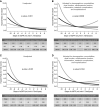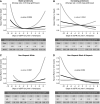Slope of Kidney Function and Its Association with Longitudinal Mortality and Cardiovascular Disease among Individuals with CKD
- PMID: 33023926
- PMCID: PMC7790212
- DOI: 10.1681/ASN.2020040476
Slope of Kidney Function and Its Association with Longitudinal Mortality and Cardiovascular Disease among Individuals with CKD
Abstract
Background: Slopes of eGFR have been associated with increased risks of death and cardiovascular events in a U-shaped fashion. Poor outcomes in individuals with rising eGFR are potentially attributable to sarcopenia, hemodilution, and other indicators of clinical deterioration.
Methods: To investigate the association between eGFR slopes and risks of death or cardiovascular events, accounting for multiple confounders, we studied 2738 individuals with moderate to severe CKD participating in the multicenter Chronic Renal Insufficiency Cohort (CRIC) Study. We used linear, mixed-effects models to estimate slopes with up to four annual eGFR assessments, and Cox proportional hazards models to investigate the association between slopes and the risks of death and cardiovascular events.
Results: Slopes of eGFR had a bell-shaped distribution (mean [SD], -1.5 [-2] ml/min per 1.73 m2 per year). Declines of eGFR that were steeper than the average decline associated with progressively increasing risks of death (hazard ratio [HR], 1.23; 95% confidence interval [95% CI], 1.09 to 1.39; for a slope 1 SD below the average) and cardiovascular events (HR, 1.19; 95% CI, 1.03 to 1.38). Rises of eGFR or declines lower than the average decline were not associated with the risk of death or cardiovascular events.
Conclusions: In a cohort of individuals with moderate to severe CKD, we observed steep declines of eGFR were associated with progressively increasing risks of death and cardiovascular events; however, we found no increased risks associated with eGFR improvement. These findings support the potential value of eGFR slopes in clinical assessment of adults with CKD.
Keywords: cardiovascular events; chronic kidney disease; epidemiology and outcomes; glomerular filtration rate; mortality risk; risk factors.
Copyright © 2020 by the American Society of Nephrology.
Figures




Comment in
-
Stopping RAS Inhibitors in Advanced Chronic Kidney Disease and Cardiorenal Outcomes-Several Unanswered Questions Remain.Am J Med. 2021 Aug;134(8):943. doi: 10.1016/j.amjmed.2021.03.031. Epub 2021 May 4. Am J Med. 2021. PMID: 33961836 No abstract available.
References
-
- Levey AS, Coresh J, Greene T, Marsh J, Stevens LA, Kusek JW, et al. .; Chronic Kidney Disease Epidemiology Collaboration: Expressing the Modification of Diet in Renal Disease Study equation for estimating glomerular filtration rate with standardized serum creatinine values. Clin Chem 53: 766–772, 2007. 10.1373/clinchem.2006.077180 - PubMed
-
- Hunsicker LG, Adler S, Caggiula A, England BK, Greene T, Kusek JW, et al. .: Predictors of the progression of renal disease in the modification of diet in renal disease study. Kidney Int 51: 1908–1919, 1997. - PubMed
-
- Khan NA, Ma I, Thompson CR, Humphries K, Salem DN, Sarnak MJ, et al. .: Kidney function and mortality among patients with left ventricular systolic dysfunction. J Am Soc Nephrol 17: 244–253, 2006. 10.1681/ASN.2005030270 - PubMed
Publication types
MeSH terms
Grants and funding
- UL1 TR000433/TR/NCATS NIH HHS/United States
- UL1 TR002548/TR/NCATS NIH HHS/United States
- U01 DK061021/DK/NIDDK NIH HHS/United States
- U24 DK060990/DK/NIDDK NIH HHS/United States
- U01 DK060963/DK/NIDDK NIH HHS/United States
- K23 DK118198/DK/NIDDK NIH HHS/United States
- U01 DK060980/DK/NIDDK NIH HHS/United States
- UL1 TR000003/TR/NCATS NIH HHS/United States
- UL1 TR000439/TR/NCATS NIH HHS/United States
- U01 DK060990/DK/NIDDK NIH HHS/United States
- U01 DK061028/DK/NIDDK NIH HHS/United States
- UL1 RR029879/RR/NCRR NIH HHS/United States
- UL1 RR024131/RR/NCRR NIH HHS/United States
- U01 DK060984/DK/NIDDK NIH HHS/United States
- UL1 TR000424/TR/NCATS NIH HHS/United States
- M01 RR016500/RR/NCRR NIH HHS/United States
- P20 GM109036/GM/NIGMS NIH HHS/United States
- U01 DK060902/DK/NIDDK NIH HHS/United States
- U01 DK061022/DK/NIDDK NIH HHS/United States
- L30 DK110819/DK/NIDDK NIH HHS/United States
LinkOut - more resources
Full Text Sources
Medical
Research Materials
Miscellaneous

